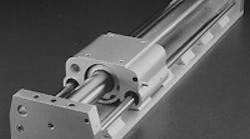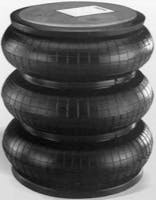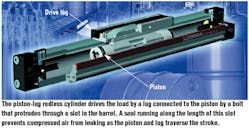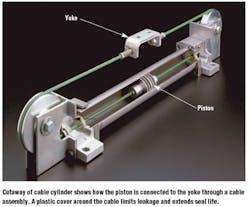Magnetic coupling of piston to lug allows rodless cylinder to drive and position loads without using any dynamic seals. Model shown has integral bearings to carry load and ensure alignment.
The flexible-wall cylinder (top) uses one or more chambers (three shown) that expand axially when pressurized. The hose type, below, expands radially when air is introduced. It applies force over a relatively long length, especially when minimal axial space is available.
When you need to move a load quickly, reliably, and in rapid succession, pneumatic cylinders generally get the nod. But what if space constraints prevent using conventional cylinders? That's what rodless cylinders were designed for. They can give the same stroke, but in about half the space. Some designs go even further by collapsing to only a fraction of their extended size.The three main types are the piston-lug cylinder, the cable cylinder, and the flexible-wall cylinder. These are generally designed for use with pneumatics, but some manufacturers provide ratings for low-pressure hydraulic service. Each basic design has inherent characteristics that make it best suited for certain types of applications. Furthermore, options available with each type only add to the versatility of rodless cylinders.
Common designs
The piston-lug cylinder works in a fashion similar to of that its conventional counterpart, but it does not move the load through a rod. Instead, a bolt extends from the side of the piston out through a longitudinal slot in the barrel. A drive lug is attached to the end of the bolt and moves directly with the piston.
To seal the slot between the piston and lug, steel bands pressing against each other separate when the bolt passes by. Different piston widths are available to meet bending moments imposed by a load. Strokes of piston-lug cylinders can exceed 30 ft. Options include position switches, brakes, and carriages to support loads and maintain alignment.
A variation of the piston-lug cylinder uses a permanent magnet in the piston to create a magnetic field that links the piston to the lug through the cylinder barrel. This eliminates the need for a longitudinal slot in the barrel and, therefore, the need for any dynamic seals. Another variation uses a magnetorheologic brake for precise position control. This magnetorheologic brake does not build up heat as friction brakes do, so it can be used to control speed as well as position.
In a cable cylinder, as the piston moves inside the cylinder barrel, it pulls a cable attached to both sides of the piston. The cable wraps around a pulley mounted at each end and attaches to a yoke. As the double-acting piston moves in one direction, the yoke travels in the opposite direction because of the wrap around the pulleys.
Options include automatic cable tensioning, single-acting models, cable tracks for greater load stabilization and capacity, a pulley arrangement to double the stroke and speed, caliper disc brakes on the cable pulley, and reed switches.
A variation of the cable cylinder relies on a metal band running over pulleys instead of a cable. Each end of the the upper yoke rides on the cylinder barrel for greater load stability and capacity, negating the need for a separate load carriage in many applications. These cylinders may be fitted with a brake that stops and holds the load anywhere along the stroke.
Flexible wall cylinders consist of metal mounting plates fixed to a reinforced rubber chamber that extends and collapses, respectively, as it is pressurized and vented. They have generous lateral misalignment allowances and can actuate through an arc without a clevis mount. In general, flexible-wall cylinders generate force only when extending, and a spring or other means may be necessary for full retraction.
Some precautions should be exercised when applying these cylinders. First, mechanical stops should be provided to limit the length of extension. Otherwise, an overrunning load could pull an end plate off the cylinder. Mechanical stops should also limit retraction, thereby preventing crushing of the elastomeric portion of the cylinder between end plates.
Alignment of these cylinders is much less critical than with conventional cylinders. However, relative torsional rotation between the end caps should be prevented to keep from having the elastomeric portion fail due to excessive shear stress.
An alternate design resembles a length of flexible hose sealed at both ends. With no pressure, the hose is flat; pumping air into it expands the hose into a tubular shape. Maximum stroke is approximately the ID of the inflated hose. Using a long length of such hose can generate very high force from a relatively low pressure. However, actuation force decreases with stroke length. This is because as the hose expands, it becomes more round, so a smaller area is in contact with the load to apply the force.
Still another variation, the Fluidic Muscle, consists of a tube with an elastomeric core reinforced with arimid fibers wound in an opposing double helical pattern. Pressurizing the tube causes it to bulge at its midpoint. This radial expansion causes the fibers to pull axially — essentially shortening the actuator. Unlike other flexible-wall actuators, the Fluidic Muscle generates force as tension.






